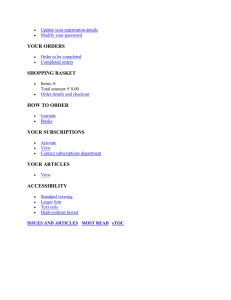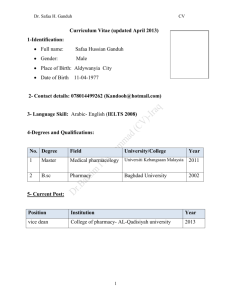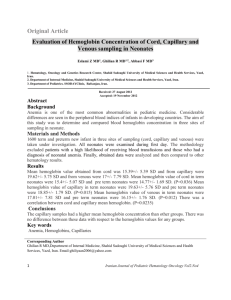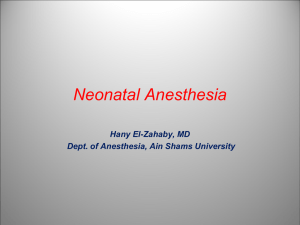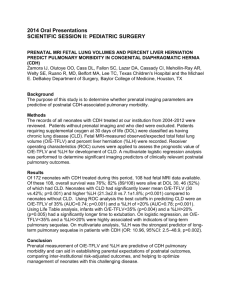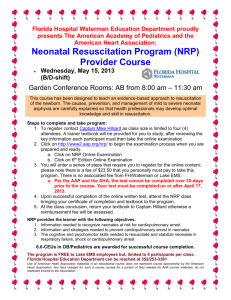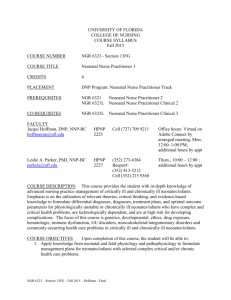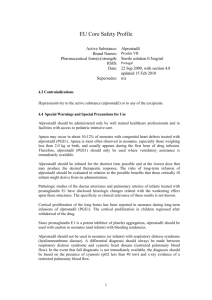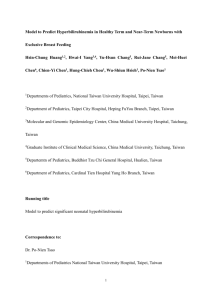neonatology blood
advertisement
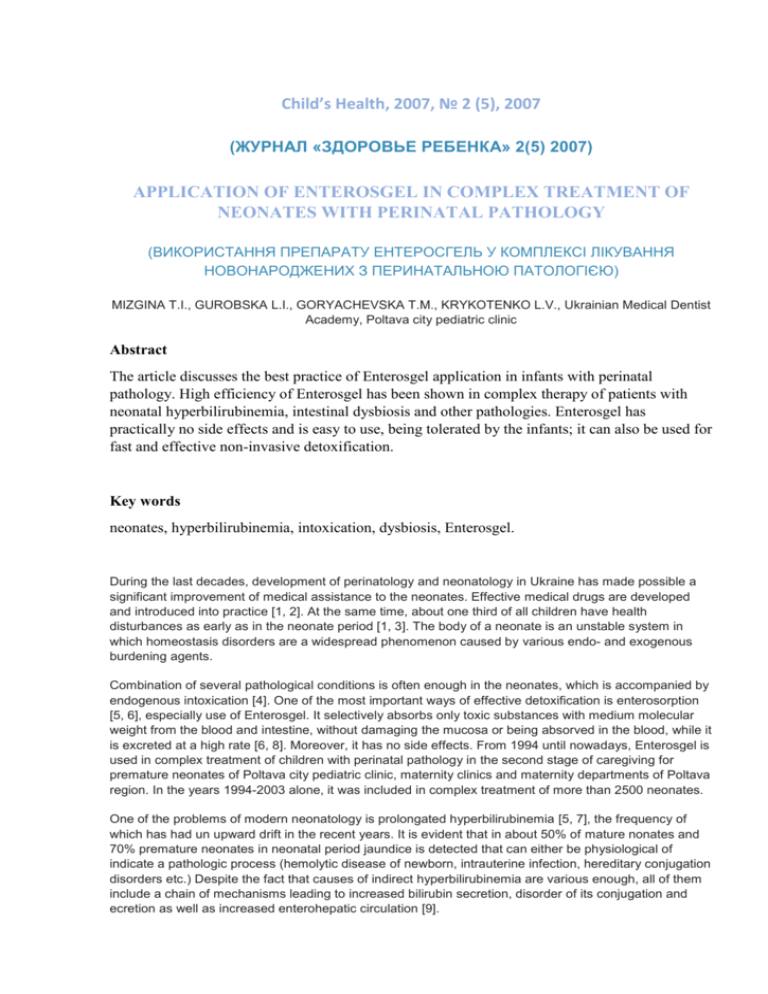
Child’s Health, 2007, № 2 (5), 2007 (ЖУРНАЛ «ЗДОРОВЬЕ РЕБЕНКА» 2(5) 2007) APPLICATION OF ENTEROSGEL IN COMPLEX TREATMENT OF NEONATES WITH PERINATAL PATHOLOGY (ВИКОРИСТАННЯ ПРЕПАРАТУ ЕНТЕРОСГЕЛЬ У КОМПЛЕКСІ ЛІКУВАННЯ НОВОНАРОДЖЕНИХ З ПЕРИНАТАЛЬНОЮ ПАТОЛОГІЄЮ) MIZGINA Т.І., GUROBSKA L.І., GORYACHEVSKA Т.М., KRYKOTENKO L.V., Ukrainian Medical Dentist Academy, Poltava city pediatric clinic Abstract The article discusses the best practice of Enterosgel application in infants with perinatal pathology. High efficiency of Enterosgel has been shown in complex therapy of patients with neonatal hyperbilirubinemia, intestinal dysbiosis and other pathologies. Enterosgel has practically no side effects and is easy to use, being tolerated by the infants; it can also be used for fast and effective non-invasive detoxification. Key words neonates, hyperbilirubinemia, intoxication, dysbiosis, Enterosgel. During the last decades, development of perinatology and neonatology in Ukraine has made possible a significant improvement of medical assistance to the neonates. Effective medical drugs are developed and introduced into practice [1, 2]. At the same time, about one third of all children have health disturbances as early as in the neonate period [1, 3]. The body of a neonate is an unstable system in which homeostasis disorders are a widespread phenomenon caused by various endo- and exogenous burdening agents. Combination of several pathological conditions is often enough in the neonates, which is accompanied by endogenous intoxication [4]. One of the most important ways of effective detoxification is enterosorption [5, 6], especially use of Enterosgel. It selectively absorbs only toxic substances with medium molecular weight from the blood and intestine, without damaging the mucosa or being absorved in the blood, while it is excreted at a high rate [6, 8]. Moreover, it has no side effects. From 1994 until nowadays, Enterosgel is used in complex treatment of children with perinatal pathology in the second stage of caregiving for premature neonates of Poltava city pediatric clinic, maternity clinics and maternity departments of Poltava region. In the years 1994-2003 alone, it was included in complex treatment of more than 2500 neonates. One of the problems of modern neonatology is prolongated hyperbilirubinemia [5, 7], the frequency of which has had un upward drift in the recent years. It is evident that in about 50% of mature nonates and 70% premature neonates in neonatal period jaundice is detected that can either be physiological of indicate a pathologic process (hemolytic disease of newborn, intrauterine infection, hereditary conjugation disorders etc.) Despite the fact that causes of indirect hyperbilirubinemia are various enough, all of them include a chain of mechanisms leading to increased bilirubin secretion, disorder of its conjugation and ecretion as well as increased enterohepatic circulation [9]. Hyperbilirubinemia treatment tactics is based on increasing effective elimination of indirect bilirubin and reduction of its toxic influence on the CNS, kidneys and cardiovascular system. Enterosorption is traditionally used in the complex of treatment methods of “indirect hyperbilirubinemia” [8]. Enterosgel was administered in relation with hyperbilirubinemia severity at a dose of 1.0 – 5.0 g/kg 3-4 times a day. It was administered per 10-30 ml at once from a spoon or via the nasogastric tube in the periods between feeding. Enterosgel was well tolerated by children. Compared with other enterosorbents, use of Enterosgel stimulated faster jaundice reduction, significantly higher reduction ratio of hyperbilirubinemia, normalization of leukocytal intoxication index, while cholestasis syndrome did not develop (Table 1). Table 1. Dynamics of values in hyperbilirubinemia treatment of the neonates Value Treatment duration, days Bilirubin reduction ratio Group I (n=78) Group II (n=25) 8.7±0.07 11.5±0.04* 0.33±0.008 0.19±0.007 Leukocytal intoxication index Day 1 of treatment 2.72±0.12 2.69±0.1 Day 7 of treatment 0.49±0.04 0.68±0.2* Cholestasis, % 2.56 16/0* Note: group I – infants before treatment complex; group II – infants treated without Enterosgel; * significant differences in values of the groups (≤0.05) It is noteworthy that during use of Enterosgel the infants did not suffer from posseting, quickly gained weight and had normal blood values of total protein and glucose. Toxic erythema is one of transition states in the neonatal period, while its etiology and consequences are quite controversial. Besides that, the authors have established a positive correlation between toxic erythema intensity and further development of atopic dermatitis in a child, other correlations being disclaimed. In case of significant increase of toxic erythema elements we administered Enterosgel at a dose 0.5-1.0 g/kg 3-4 times a day. As early as by the end of day 1 of use of Enterosgel, eruption intensity reduces, while on day 2 it disappears. We also use Enterosgel in complex therapy of neonates with symptoms of intestinal dysbiosis. Its ability of selective interaction with microbial cells is important in this case: normal lactic acid microflora is not absorbed or oppressed, while opportunistic pathogens and pathogens are destroyed. Enterosgel is used at a dose from 0.5-1.5 g/kg per day, thus normalization of stool character and frequency had been already detected by day 3-4, with reduction of such symptoms as flatulence and posseting. Until days 7-10, level of pathogenic microflora significantly decreased in stool culture (Table 2). Compared with infants treated with only biomedicines, in the patients whose treatment included Enterosgel, a significant improvement of lactic acid flora and faster intestinal dysbiosis normalization. Table 2. Dynamics of values in intestinal dysbiosis treatment of the neonates Value Group I (n=78) Symptom reduction rate, days Group II (n=25) Flatulence Restlessness Pathologic stool Posseting 3.2±0.06 2.1±0.03 2.8±0.07 2.4±0.04 Intestinal flora normalization 14.8 61.7 93.8 91.4 5.2±0.09* 5.2±0.07* 5.3±0.12* 3.7±0.03 Day 5 8.0* Day 7 48.0* Day 14 76.0* Restoration of normal intestinal 72.0* microflora, % Note: group I – infants before treatment complex; group II – infants treated without Enterosgel; * significant differences in values of the groups (≤0.05) Taking into consideration earlier studies of Enterosgel application in treatment of drug and alcohol intoxication of adult patients, we used it in children born from women suffering from drug abuse. Thanks to inclusion of Enterosgel in the treatment complex, these infants seldom suffered from posseting, irritability of newborn as well as they better gained the weight. As a result, it allowed to refuse of infusion therapy as a detoxification method in the large part of the cases. It is noteworthy that during the whole period of Enterosgel application in the neonates no adverswe event was recorded. In some children administration of Enterosgel was accompanied with stool reduction that resulted in decrease of its concentration. Thus, Enterosgel application in the treatment complex of neonates with perinatal pathology is effective enough. It has practically no side effects or negative effects, is well tolerated by infants and can also be used for fast and effective non-invasive detoxification. References 1. Lukyanova E.M. Modern perinatal protection of fetus. Tasks and perspectives / Doctor, 2001. № 3. P. 8. 2. Sulima O.G. Organization of medical assistance to the neonates in Ukraine: studies, problems and perspectives / Science and practical conference “Actual problems of organization medical assistance to the neonates. Kyiv, 2003. Pp. 5-7. 3. Moiseenko R.A. Health protection of the mothers and the children in Ukraine: problems and perspectives/ Women’s Health, 2003. № 3. pp. 8-16. 4. Mezhirova N.M. Course and treatment specific of endogenous intoxication in the neonatal period/ II Ukrainian National Congress of anesthesiologists. Congress work materials. Kyiv, 1996. P. 114. 5. Rubina O.S. Evidence of Polisorb application in the neonates/ PAG, 1997. № 3. pp. 50-51. 6. Georgiantz M.A. Optimization of intensive therapy tactics using enterosorption in critical conditions of children / VIII Congress of Ukrainian anesthesiologists. Theses. Charkiv, 1996. P. 109. 7. Traverov G.M., Tsvirenko S.M., Mizgina T.I. Jaundice of neonates. Poltava, Verstka, 2003. 88 p. 8. Vasilchenko L.V. Clinical significance of enterosorption in complex treatment of hemolytic disease of newborn. Synopsis of thesis for PhD in medicine. Kyiv, 2000. P. 19.
